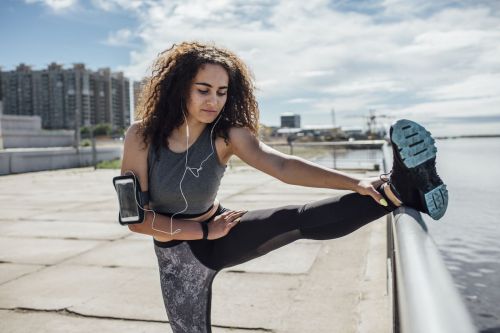Tight hammies? Might be because you’re sitting at your desk all day
There are *so* many sneaky reasons why you can have tight hamstrings. Trainers explain how to deal (stretch!) and prevent them from happening.

If there’s one part of my body that is literally sore 24/7, no matter how good I am about stretching and foam rolling, it’s definitely my hamstrings. It’s pretty unfortunate, considering how large the muscle is and how often you use it (which is basically… always). You know what I’m talking about if you’ve ever let out a big groan or sigh of pain while doing the most minor of things, such as leaning down or walking upstairs, or even standing up (amirite?).
“It’s extremely common to have tight hamstrings,” says Kit Rich, celebrity trainer and founder of KICHGO. “Tight hamstrings, for the most part, are genetic—I’d say that’s the number one reason.” Ahem, thanks mom and dad. But muscle imbalances are also play a role “Your hamstrings will tighten when you work them out. They’ll also tighten if other parts of your body are weak and your hamstrings tighten in response to ‘help’—so, for instance, if you’re weak in the hips or lower back, your hamstrings will tighten more.”
If you’re moving with your pelvis tucked or your weight shifted forward on your feet, Bloom points out that you’re probably “working your hamstrings overtime.” Or if your back is weak, your hamstrings will tighten up to compensate for that. “And not teaching the hamstrings to work eccentrically and at length or not properly supporting with your core and other leg muscles can also lead to chronically short hamstrings,” she explains.
You don’t necessarily have to work them out to cause the tightness, though, because the opposite can lead to the same thing. As in, those 8+ hours a day you’re spending parked at your desk aren’t doing your hammies any favors. “If you are not actively walking, jogging, running, or taking stairs, you’re most likely to have tight hamstrings since you’re not taking the time to open your stride,” says Carlisle Price, NCSF, a Gold’s Gym certified personal trainer. So yeah, it’s pretty easy to get tight on that big muscle on the upper back of your legs.
How to stretch out those hammies
Stretching and lengthening your hamstrings is about as important as exfoliating your skin: You should be doing it on the reg. “You can do hamstring exercises every day—it’ll help not only with increasing flexibility, but also help to decrease pressure in the back and hips,” says Rich. “It can also reduce the risk of injury and improve posture.” These are all the things you can do to stay on top of it, for the sake of, well, not groaning whenever you’re moving (like me these days).
Pilates: This fitness modality—which is known for “lengthening and strengthening”—is gentle on the body and helps to stretch everything out. “Pilates is the ideal exercise for both lengthening the hamstrings and correcting the imbalances that lead to hamstring issues,” says Bloom.
Yoga: Yoga’s the obvious answer for a gentle thing to do that stretches and opens up your muscles, and there are plenty of asanas work magic on your hammies. “I like to incorporate basic yoga movements like downward dog—this lengthens your hamstrings and calves, releasing tension that might be causing the tightness in your hamstrings,” says Price. “My other favorite stretch is the triangle stretch. To perform the stretch, start in a front-to-back split stance with both legs straight. Bow towards your front legs and raise your toe.”
Hamstring-specific stretches: There’s a whole smattering of hamstring stretches that you can do on their own, which will work to ease that tightness. “One simple stretch is lying on your back with one leg up using a yoga strap around the foot,” says Bloom. And there’s touching your toes, or putting your foot on something at waist-level and bending towards your thigh.
Strengthen your hamstrings: Combatting tightness can also come from working the muscles themselves—so, making them stronger can essentially help with stretching them out. Price says that the deadlift, Romanian deadlift, and kettlebell swing can work the muscles in that area—as long as they’re done in proper form—can stretch and lengthen your hamstrings. “There should be minimal knee and maximum hip hinging when performing the movements,” he says.
Have proper form, always: Speaking of form, trainers agree that having proper form is the most important thing when it comes to staying on top of hamstring issues. “It comes down to the fundamental basics of a movement,” says Price. “By practicing proper form during your workouts, you’ll minimize your chances of tight hamstrings.” This is something to also pay attention to with weights machines, so be sure adjust them to your height and read the instructions if you’re not sure on how to use them. Loose legs, here you come.
BTW, these are all of the reasons why flexibility is important (it’s not just for having pliable hamstrings). And here’s why big toe flexibility, specifically, is key for your fitness game.
Sign Up for Our Daily Newsletter
Get all the latest in wellness, trends, food, fitness, beauty, and more delivered right to your inbox.
Got it, you've been added to our email list.










